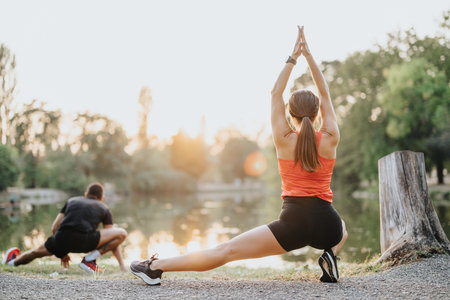1. The Shift from Gyms to Living Rooms
In recent years, Americans have experienced a major shift in how they approach fitness. Instead of heading to crowded gyms, more people are choosing to work out at home. This change didn’t happen overnight—it’s the result of both cultural changes and advances in technology.
Cultural Factors Influencing Home Workouts
Several cultural trends have played a role in this movement. For many, busy schedules and family commitments made it tough to fit in gym visits. The desire for convenience and flexibility became a top priority. On top of that, the COVID-19 pandemic forced gyms to close temporarily, making home workouts not just convenient, but necessary.
| Cultural Factor | Impact on Fitness Habits |
|---|---|
| Busy Lifestyles | People want quick, flexible workouts that fit into packed schedules. |
| Pandemic Lockdowns | Forced closure of gyms led to creative home workout solutions. |
| Family Time | Exercising at home allows parents to stay active without leaving kids behind. |
| Desire for Privacy | Some prefer working out alone rather than in public spaces. |
Technological Advances Making Home Fitness Easier
Technology has made it easier than ever for Americans to get a great workout at home. Streaming services offer thousands of fitness classes on demand, from yoga and HIIT to dance cardio. Smart fitness equipment like Peloton bikes and Mirror home gyms bring interactive training right into the living room. Wearable devices track progress and provide motivation with real-time feedback.
| Tech Innovation | Description | Benefit for Home Users |
|---|---|---|
| Fitness Apps & Streaming Classes | On-demand workouts via smartphones or smart TVs | No need for expensive gym memberships; endless variety of classes available anytime. |
| Smart Equipment (Peloton, Mirror) | Interactive gear with live or pre-recorded coaching sessions | Professional instruction and community feel at home. |
| Wearables (Fitbit, Apple Watch) | Devices tracking heart rate, calories burned, and activity levels | Personalized data helps users set goals and stay motivated. |
The New Normal in American Fitness Culture
This combination of cultural shifts and technological advancements has redefined what it means to “work out” in America. Today’s fitness routines are more personal, convenient, and accessible than ever before—right from the comfort of home.
2. The Rise of Virtual Fitness Communities
As Americans adapted to home workouts, many turned to the internet to find connection and motivation. Online platforms and social media have made it possible for people to stay active, share their fitness journeys, and hold each other accountable—all from the comfort of their own homes.
How Virtual Communities Support Home Fitness
These digital communities provide a sense of belonging and encouragement that can be hard to find when working out alone. Whether through group challenges, livestreamed classes, or simple daily check-ins, virtual fitness groups help keep members on track.
Popular Platforms for Home Workout Communities
| Platform | Main Features | Community Style |
|---|---|---|
| Workout videos, fitness challenges, progress sharing | Hashtags, influencer-led groups | |
| Facebook Groups | Private support groups, accountability threads, live classes | Peer-to-peer support, local and national groups |
| YouTube | Free workout tutorials, live streams, comment sections | Global audience, interactive comments |
| Peleton App & Community | Live and on-demand classes, leaderboard competition | Brand-driven network, virtual high-fives |
| TikTok | Quick tips, trending fitness routines, user-generated content | Youthful trends, viral challenges |
The Power of Accountability and Motivation Online
Staying motivated at home isn’t always easy. That’s why many Americans use online groups to set goals together and celebrate small wins. Some join step-count competitions with friends using apps like Fitbit or Apple Health. Others take part in monthly challenge calendars posted by fitness influencers. In these spaces, sharing progress photos or daily updates helps keep everyone moving forward.
Examples of Online Accountability Methods:
- Posting daily workout selfies in private Facebook groups
- Joining a 30-day push-up challenge on Instagram Stories
- Tracking steps or calories burned with app-based leaderboards
- Catching up with virtual workout buddies over Zoom or FaceTime
- Liking and commenting on each others progress posts for encouragement
The rise of virtual fitness communities has truly changed how Americans experience home workouts. These online spaces not only offer workout ideas but also foster a spirit of teamwork and shared achievement—no gym membership required.
![]()
3. Innovations in Home Workout Equipment and Technology
Home workouts in America have come a long way from simple yoga mats and dumbbells. Today, technology is making it easier and more fun to stay fit at home. Smart fitness devices, workout apps, and subscription-based platforms are changing the game, helping people stay active without ever stepping foot in a gym.
Smart Fitness Devices
Americans love gadgets that make life easier, and fitness is no exception. Smart equipment like connected treadmills, stationary bikes, and rowing machines offer interactive screens and real-time feedback. Brands like Peloton and NordicTrack are popular choices because they let users join live or on-demand classes right from their living room.
| Device Type | Main Features | Popular Brands |
|---|---|---|
| Smart Bike | Live classes, leaderboards, performance tracking | Peloton, Echelon |
| Smart Treadmill | Virtual trails, personalized coaching | NordicTrack, ProForm |
| Fitness Mirror | Full-body workouts, real-time feedback | Tonal, MIRROR |
| Wearable Tracker | Heart rate monitoring, step count, sleep tracking | Fitbit, Apple Watch |
Workout Apps That Motivate
Workout apps are another big reason why exercising at home is so popular now. These apps provide guided routines for everything from strength training to meditation. With reminders and progress tracking, it’s easier than ever to stick with a plan.
- Centr: Offers workouts, meal plans, and mindfulness tools all in one place.
- Nike Training Club: Free and premium workouts for every level.
- Aaptiv: Audio-guided routines for running, yoga, HIIT, and more.
- Peloton App: Not just for bike owners—stream classes for yoga, strength, cardio, and more.
The Rise of Subscription-Based Fitness Platforms
The American approach to fitness is also shifting thanks to subscription-based services. Monthly memberships give access to hundreds or even thousands of classes led by expert trainers. This makes high-quality instruction affordable and accessible to everyone.
Main Benefits of Subscription Platforms:
- Diversity: Try new workouts anytime—boxing one day, pilates the next.
- Community: Join virtual groups for extra motivation and support.
- Flexibility: Work out any time that fits your schedule.
- No Commute: Save time and money by exercising at home.
The combination of innovative equipment, smart apps, and flexible subscriptions means Americans can personalize their fitness journey like never before. The future of home workouts looks brighter—and smarter—every year.
4. Inclusivity and Diversity in Home Fitness
One of the most exciting changes in the evolution of home workouts is how they have opened the door for everyone to join in, no matter their background or ability. In the past, fitness could feel exclusive—limited by expensive gym memberships, location, or even social pressures. Today, home workouts are breaking down these barriers and making fitness more inclusive than ever before.
Access for All
Thanks to technology and online platforms, people from different communities, age groups, body types, and ability levels can all find a workout that fits their needs. Whether you’re a busy parent, a college student on a budget, or someone with limited mobility, there are options available at your fingertips. Many trainers now offer classes tailored for seniors, adaptive workouts for people with disabilities, and programs in multiple languages.
How Home Workouts Make Fitness Inclusive
| Barrier | Traditional Gyms | Home Fitness Solutions |
|---|---|---|
| Cost | High membership fees | Free/affordable apps & YouTube videos |
| Location | Need to travel to gym | Workout anywhere at home |
| Cultural representation | Limited diversity in staff/content | Diverse trainers & styles online |
| Physical ability | Few adaptive classes offered | Accessible workouts for all abilities |
| Body image pressure | Gym intimidation factor | No judgment zone at home |
The Rise of Diverse Fitness Communities Online
Social media and streaming services have created spaces where people can connect based on shared interests or identities. From Black-led yoga sessions to LGBTQ+-friendly HIIT classes and plus-size dance parties, Americans are redefining what it means to be fit—and who gets to join the movement. This shift toward inclusivity is helping more people feel welcome and empowered on their fitness journey.
5. New Definitions of Success and Well-being
As home workouts have become a part of daily life for many Americans, the idea of what it means to be “fit” is changing. More people are moving away from chasing the perfect body or six-pack abs, and instead, they’re focusing on feeling good inside and out. Mental health, balance, and routines that actually fit into busy lives are now at the heart of fitness goals.
Mental Health Takes Center Stage
Americans are realizing that exercise is about more than just looks. Many home workout programs now include meditation, mindful movement, and breathing exercises. These help reduce stress, improve sleep, and boost overall mood. Apps and online communities encourage people to share not just physical progress, but also how they’re managing anxiety or staying positive.
Balance Over Burnout
Instead of pushing hard every single day, there’s a new emphasis on listening to your body. Rest days are celebrated as much as workout days. People want routines that give energy, not drain it. Mixing up activities like yoga, walking, dancing, or gentle strength training is becoming more popular because it keeps things fun and sustainable.
Comparing Old vs. New Fitness Goals
| Traditional Fitness Goals | Modern Home Workout Goals | |
|---|---|---|
| Main Focus | Physical appearance (muscles, weight loss) | Mental health & well-being |
| Routine Style | Intense daily workouts | Flexible schedules & varied activities |
| Success Markers | Pounds lost, inches dropped | Lower stress, better sleep, feeling energized |
| Community Sharing | Before-and-after photos | Sharing self-care tips & positive habits |
Sustainability Matters Most
The trend now is to build habits that last all year—not just during New Year’s resolutions or summer. Americans are choosing realistic goals that fit around work-from-home schedules, family time, and social lives. Even short 10-minute routines are seen as wins if they help you feel better each day.
A Shift in What “Success” Means
This new mindset means success isn’t about being perfect—it’s about making choices that support your mind and body in the long run. Whether it’s meditating after a tough work call or taking a walk with your dog, small steps add up to real progress in well-being.


